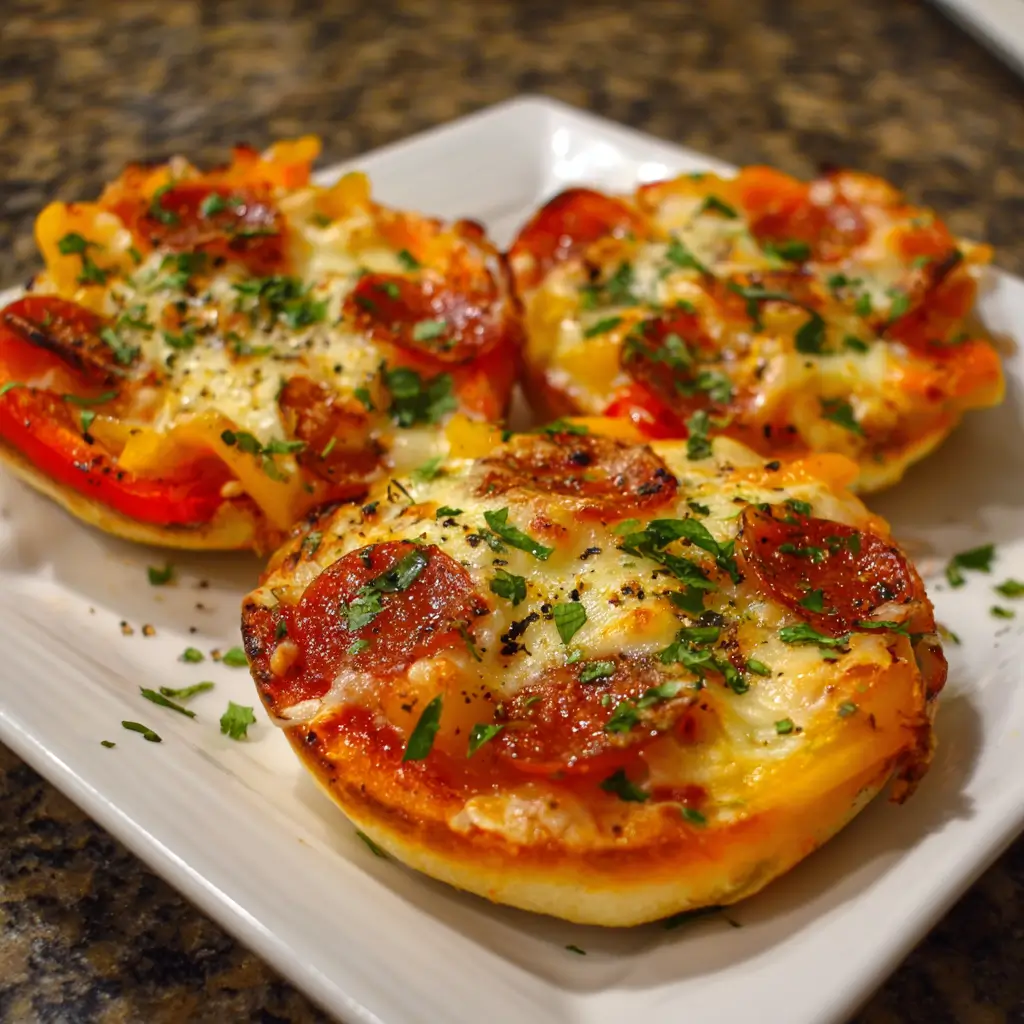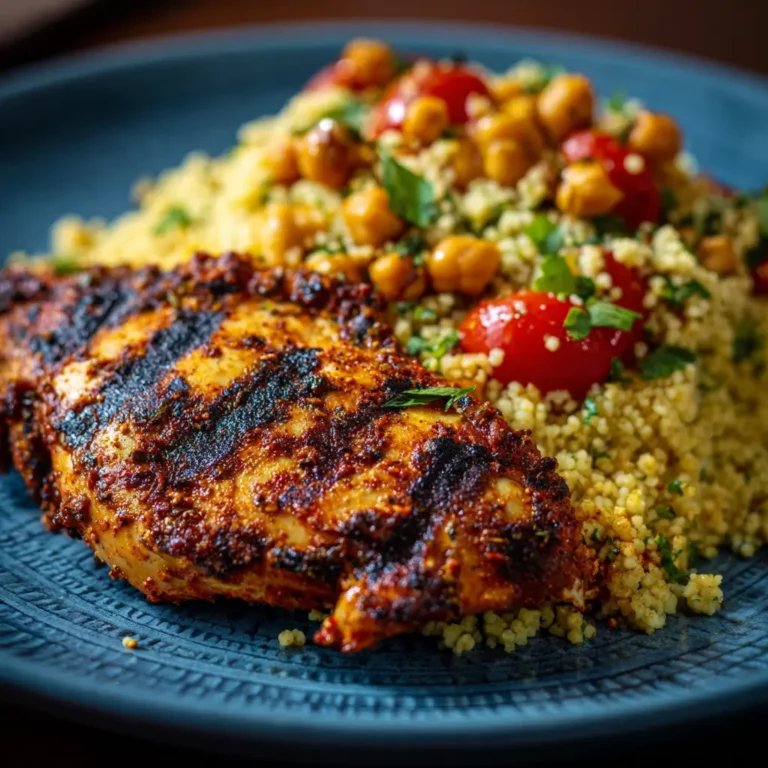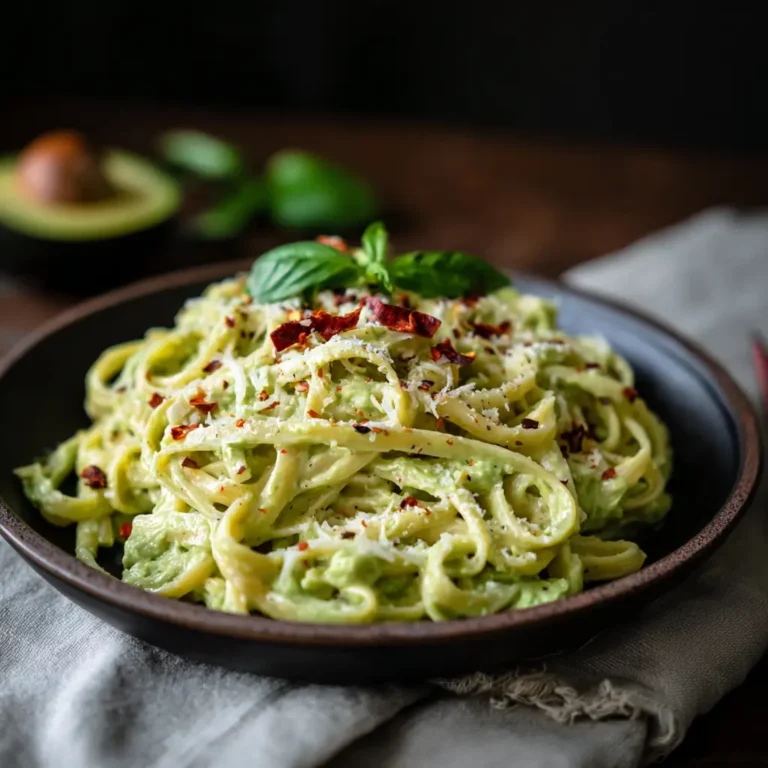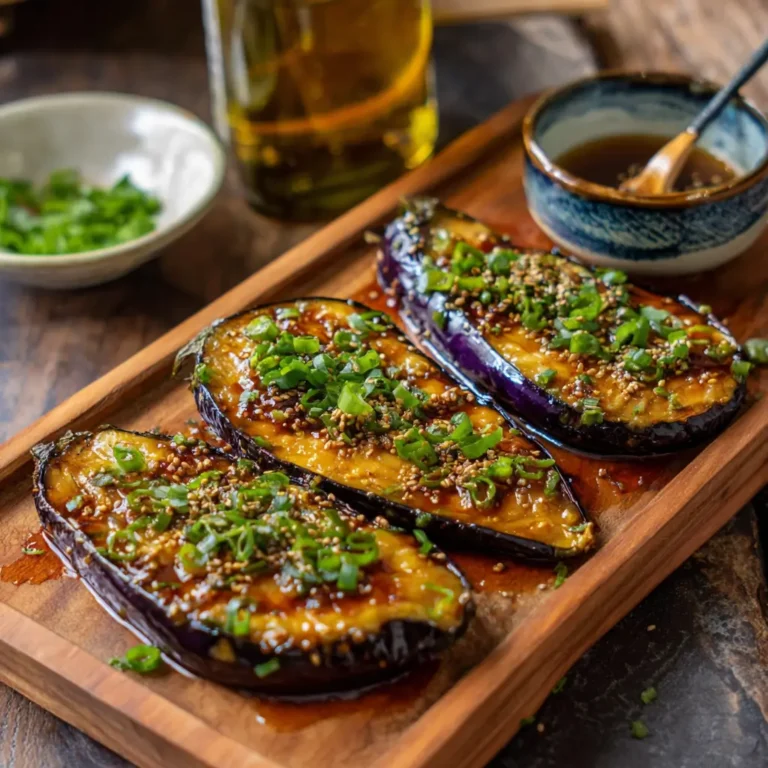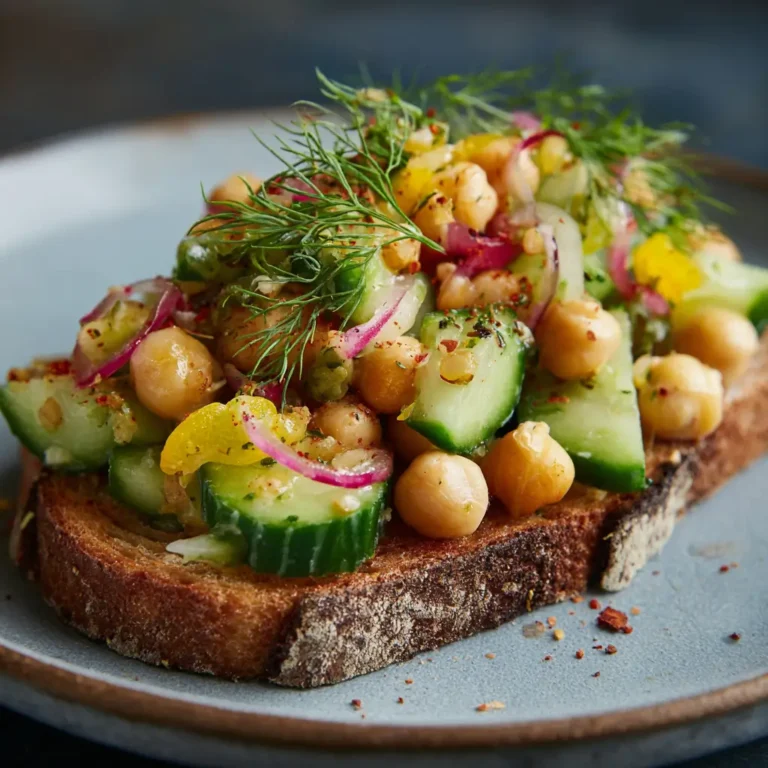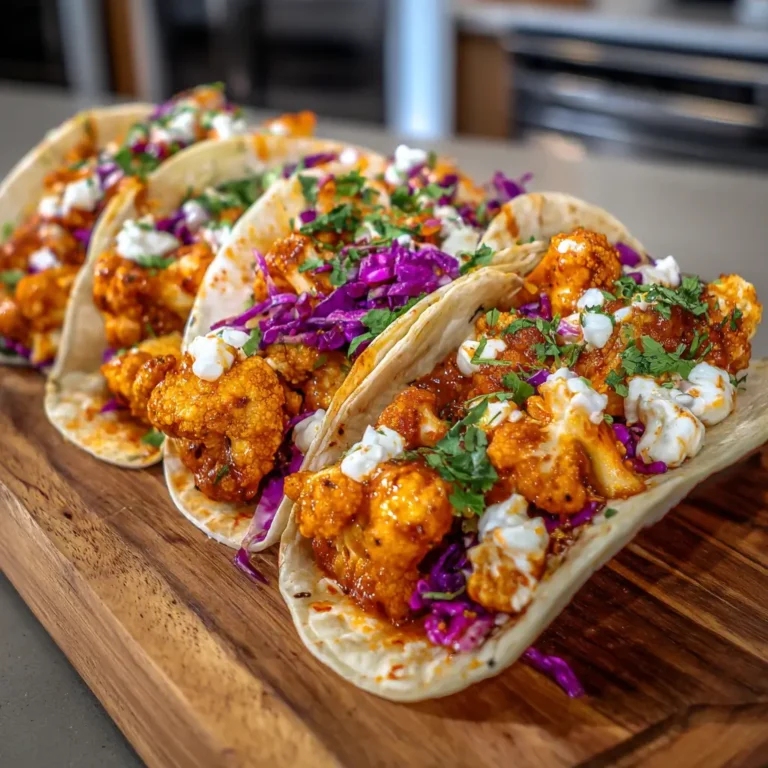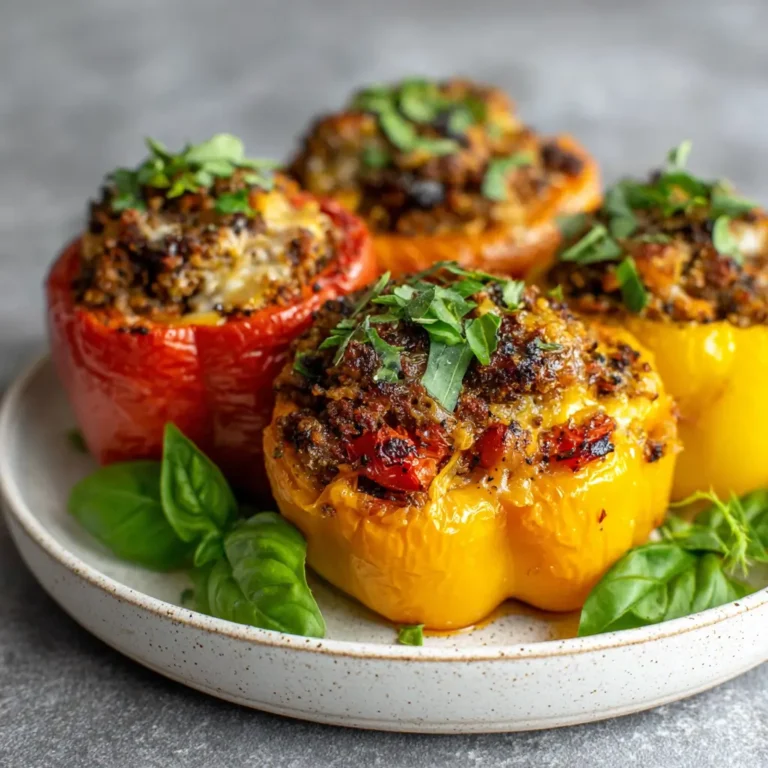Mini Pepper Pizzas
Introduction
Mini Pepper Pizzas are a delightful fusion of fresh vegetables and classic pizza flavors, making them a perfect appetizer, snack, or even a light meal. These adorable little pizzas are not only visually appealing but also packed with flavor and nutrition. Ideal for parties, family dinners, or meal prep, they offer a healthier alternative to traditional pizza without compromising on taste. Whether you’re cooking for kids, entertaining guests, or simply craving something savory and satisfying, Mini Pepper Pizzas are an excellent choice that combines simplicity, creativity, and wholesome ingredients in every bite.
The History
The concept of using vegetables as edible vessels for toppings dates back centuries, rooted in various culinary traditions around the world. Stuffed vegetables have been a staple in Mediterranean, Middle Eastern, and Eastern European cuisines—think of stuffed grape leaves, bell peppers filled with rice and meat, or zucchini boats baked with cheese and herbs. The idea of transforming mini bell peppers into individual-sized pizzas is a modern twist inspired by the growing popularity of low-carb, gluten-free, and vegetable-forward diets.
In recent years, food trends emphasizing portion control, visual appeal, and healthy eating have propelled recipes like Mini Pepper Pizzas into the spotlight. Social media platforms such as Instagram and Pinterest have amplified their popularity, showcasing vibrant images of colorful peppers topped with melty cheese and fresh herbs. While there’s no definitive origin story, these miniature delights emerged from a blend of Italian pizza culture and contemporary wellness-focused cooking, offering a fun and nutritious way to enjoy one of the world’s favorite foods—pizza—in a whole new form.
Ingredients Breakdown
Creating delicious Mini Pepper Pizzas starts with selecting high-quality, fresh ingredients. Each component plays a vital role in achieving the right balance of flavor, texture, and nutrition.
- Mini Bell Peppers: The star of the dish, mini bell peppers are small, sweet, and crisp. They come in red, yellow, and orange varieties, all rich in vitamin C and antioxidants. Their natural cup-like shape makes them ideal for holding toppings without needing additional support.
- Pizza Sauce: A classic marinara or homemade tomato sauce forms the base layer, adding tangy richness. Look for low-sugar, organic options or make your own using crushed tomatoes, garlic, olive oil, and Italian herbs.
- Mozzarella Cheese: Freshly grated mozzarella provides that signature gooey, melty texture when baked. Opt for part-skim or whole-milk mozzarella depending on your preference for richness.
- Parmesan Cheese: Adds a sharp, salty depth. Grated Parmigiano-Reggiano enhances the umami profile and complements the mild mozzarella.
- Pepperoni Slices (optional): For meat lovers, thinly sliced pepperoni adds a smoky, spicy kick. You can use turkey pepperoni for a lighter option or omit it entirely for a vegetarian version.
- Fresh Basil: Brings brightness and aromatic freshness. Add it after baking to preserve its delicate flavor and vibrant color.
- Olive Oil: A drizzle of extra virgin olive oil before baking enhances moisture and adds a luxurious mouthfeel.
- Garlic Powder & Italian Seasoning: These seasonings deepen the savory notes and give the pizzas an authentic Italian flair.
- Salt and Black Pepper: Essential for balancing and enhancing all other flavors.
Optional add-ins include mushrooms, spinach, onions, olives, pineapple, feta cheese, or even a poached egg for a brunch twist. The beauty of this recipe lies in its versatility and adaptability to personal tastes and dietary needs.
Step-by-Step Recipe
- Preheat the Oven: Begin by preheating your oven to 375°F (190°C). This ensures even cooking and proper melting of the cheese without overcooking the peppers.
- Prepare the Peppers: Wash 12–16 mini bell peppers thoroughly under cold water. Slice off the tops horizontally, then carefully remove the seeds and inner membranes using a small spoon or knife. Try to keep the stems intact for a rustic presentation.
- Blanch the Peppers (Optional): To soften the peppers slightly and reduce bitterness, blanch them in boiling water for 2–3 minutes, then immediately transfer to an ice bath. Drain well and pat dry. This step is optional but recommended if you prefer a more tender texture.
- Arrange on Baking Sheet: Place the prepared pepper halves cut-side up on a parchment-lined or lightly greased baking sheet. Arrange them snugly but not touching to allow heat circulation.
- Add Pizza Sauce: Using a small spoon or piping bag, add about 1 teaspoon of pizza sauce into each pepper half. Spread gently to cover the bottom evenly.
- Sprinkle Cheese Base: Add a thin layer of shredded mozzarella over the sauce—about 1 tablespoon per pepper. This helps bind the toppings together.
- Add Toppings: Place 1–2 small pieces of pepperoni (if using) or any desired vegetables like chopped mushrooms, onions, or olives on top of the cheese layer.
- Final Cheese Layer: Cover the toppings with another generous pinch of mozzarella and a sprinkle of Parmesan cheese for added flavor and browning.
- Season: Lightly dust each pepper pizza with garlic powder, dried oregano, basil, salt, and black pepper. Drizzle a few drops of olive oil over the top to enhance richness and prevent drying.
- Bake: Transfer the baking sheet to the preheated oven and bake for 12–15 minutes, or until the cheese is fully melted, bubbly, and slightly golden at the edges. Rotate the pan halfway through for even cooking.
- Garnish and Serve: Remove from the oven and let cool for 2–3 minutes. Top each mini pizza with a small fresh basil leaf or a sprinkle of red pepper flakes for heat. Serve warm.
Tips
- Choose Uniform Peppers: Select mini bell peppers that are similar in size for consistent cooking. Avoid overly soft or bruised ones.
- Don’t Overfill: Keep toppings minimal to prevent the peppers from becoming soggy or tipping over during baking.
- Grate Your Own Cheese: Pre-shredded cheese often contains anti-caking agents that can affect meltability. Freshly grated melts smoother and tastes better.
- Use Parchment Paper: Prevents sticking and makes cleanup easier. Aluminum foil can work too, but may cause slight browning underneath.
- Watch Closely During Baking: Mini peppers cook quickly. Overbaking can lead to wrinkled skins and mushy textures.
- Cool Before Serving: Let them rest briefly after baking so the cheese sets slightly and doesn’t burn your mouth.
- Make Ahead Tip: Assemble the pizzas ahead of time and refrigerate for up to 24 hours before baking. Add a minute or two to the baking time if starting from cold.
- Double Batch Friendly: These freeze well unbaked. Freeze assembled peppers on a tray, then store in a container. Bake straight from frozen, adding 5–7 minutes to the cooking time.
Variations and Customizations
One of the greatest strengths of Mini Pepper Pizzas is their incredible flexibility. Here are some creative variations to suit different palates and occasions:
- Veggie Lover’s Version: Skip the meat and load up with sautéed mushrooms, spinach, diced zucchini, cherry tomatoes, and black olives. Add a touch of ricotta for creaminess.
- White Pizza Style: Omit tomato sauce and use a base of ricotta mixed with garlic, Parmesan, and herbs. Top with mozzarella and fresh arugula after baking.
- BBQ Chicken Style: Use barbecue sauce instead of marinara, add shredded cooked chicken, red onion, and a blend of cheddar and mozzarella.
- Mediterranean Twist: Use hummus or tzatziki as the base, top with crumbled feta, kalamata olives, cucumber, and fresh dill.
- Breakfast Pizzas: Crack a small egg into each pepper after adding cheese, then bake until the egg is set. Great for weekend brunch!
- Dessert Pizzas: Yes, really! Use halved strawberries or apples as the base, spread with almond butter or cream cheese, and top with dark chocolate chips, coconut, and cinnamon.
- Keto/Low-Carb Friendly: Naturally low in carbs, these pizzas fit perfectly into ketogenic or low-carb lifestyles. Just ensure your sauce has no added sugar.
- Gluten-Free Option: All ingredients are naturally gluten-free, making this a safe and tasty option for those with celiac disease or gluten sensitivity.
- Plant-Based/Vegan Version: Substitute dairy cheese with vegan mozzarella shreds, use plant-based pepperoni, and choose a vegan-friendly sauce. Nutritional yeast can boost the cheesy flavor.
Health Considerations and Nutritional Value
Mini Pepper Pizzas are not just delicious—they’re also a nutrient-dense food choice that supports a balanced diet.
Nutritional Highlights:
- Rich in Vitamin C: One mini bell pepper contains more than 100% of the daily recommended intake of vitamin C, supporting immune function and skin health.
- Low in Calories: Each mini pepper has only about 5–10 calories, making them a great low-calorie base for flavorful toppings.
- High in Antioxidants: Carotenoids like beta-carotene and lutein found in colorful peppers help combat oxidative stress and support eye health.
- Good Source of Fiber: The vegetable base contributes dietary fiber, aiding digestion and promoting satiety.
- Calcium and Protein from Cheese: Mozzarella and Parmesan provide essential amino acids and bone-supporting calcium.
- Healthy Fats: Olive oil and full-fat cheese contribute monounsaturated fats, which support heart health when consumed in moderation.
Considerations:
- Sodium Content: Store-bought sauces and processed meats like pepperoni can be high in sodium. Opt for low-sodium versions or make your own sauce and use uncured, nitrate-free meats.
- Dairy Sensitivity: Those who are lactose intolerant should consider lactose-free cheese alternatives or reduce cheese quantity.
- Portion Control: While healthy, cheese and oils are calorie-dense. Stick to moderate portions unless following a high-energy diet.
- Allergens: Contains dairy; possible cross-contamination with gluten if using non-certified ingredients. Always check labels if serving individuals with allergies.
On average, one Mini Pepper Pizza (with sauce, cheese, and pepperoni) contains approximately:
- Calories: 45–60 kcal
- Protein: 3–4 g
- Fat: 3–5 g (mostly unsaturated)
- Carbohydrates: 3–5 g
- Fiber: 1–1.5 g
- Sugar: 2–3 g (naturally occurring)
- Sodium: 150–250 mg (varies by ingredients)
Ingredients
- 12–16 mini bell peppers (assorted colors)
- ¼ cup pizza sauce (or marinara sauce)
- 1 cup shredded mozzarella cheese
- ¼ cup grated Parmesan cheese
- 12–16 slices pepperoni (optional, or substitute with turkey pepperoni or veggie pepperoni)
- 1 tbsp olive oil
- ½ tsp garlic powder
- ½ tsp Italian seasoning (or dried oregano and basil mix)
- Salt and freshly ground black pepper to taste
- Fresh basil leaves for garnish
- Red pepper flakes (optional, for spice)
Directions
- Preheat oven to 375°F (190°C). Line a baking sheet with parchment paper or lightly grease it.
- Wash the mini bell peppers. Cut off the tops and remove seeds and membranes. Pat dry inside and out.
- (Optional) Blanch peppers in boiling water for 2–3 minutes, then shock in ice water. Drain and place cut-side up on the baking sheet.
- In a small bowl, mix pizza sauce with half of the Italian seasoning. Set aside.
- Spoon about 1 teaspoon of sauce into each pepper half. Spread gently to coat the bottom.
- Sprinkle a layer of mozzarella (about 1 tbsp) over the sauce in each pepper.
- Add a piece of pepperoni or other toppings as desired.
- Add another pinch of mozzarella and a sprinkle of Parmesan on top.
- Season with garlic powder, remaining Italian seasoning, salt, and black pepper.
- Drizzle lightly with olive oil.
- Bake for 12–15 minutes, until cheese is melted, bubbly, and lightly browned.
- Remove from oven and let cool for 2–3 minutes.
- Garnish with fresh basil and red pepper flakes if desired.
- Serve warm as an appetizer, snack, or side dish.
FAQ
Can I make Mini Pepper Pizzas ahead of time?
Yes! Assemble them up to 24 hours in advance and refrigerate covered. Bake just before serving for best results.
Can I freeze Mini Pepper Pizzas?
Absolutely. Freeze uncooked assembled peppers on a tray, then transfer to a freezer-safe container. Bake from frozen, adding 5–7 minutes to the cooking time.
Are Mini Pepper Pizzas keto-friendly?
Yes, they are naturally low in carbohydrates and fit well within a ketogenic diet, especially when using low-sugar sauce and minimal toppings.
What can I use instead of pepperoni?
Try cooked sausage crumbles, grilled chicken, ham, bacon bits, tofu, tempeh, or simply go vegetarian with extra veggies.
Why are my peppers watery after baking?
This usually happens if the peppers weren’t dried properly or were overfilled. Try blotting insides with a paper towel before filling, and avoid excessive sauce.
Can I cook these in an air fryer?
Yes! Air fry at 350°F (175°C) for 8–10 minutes, checking frequently to avoid burning.
Are mini bell peppers the same as baby bell peppers?
Yes, “mini” or “baby” bell peppers are the same—small, sweet varieties typically measuring 2–3 inches long, harvested young or bred to stay small.
Can I use regular bell peppers?
Yes, but larger peppers will need to be cut into rings or quarters. Adjust baking time accordingly, as thicker walls may require 15–20 minutes.
Summary
Mini Pepper Pizzas are a creative, healthy, and delicious way to enjoy the flavors of pizza with a nutritious twist. Packed with vibrant vegetables, melty cheese, and customizable toppings, they’re perfect for any occasion.
